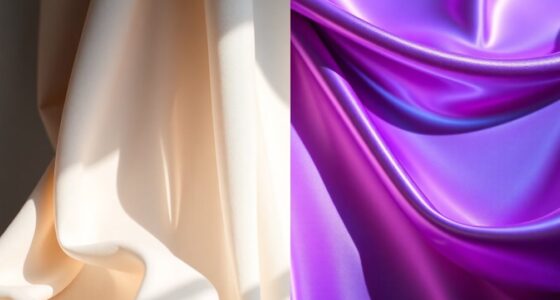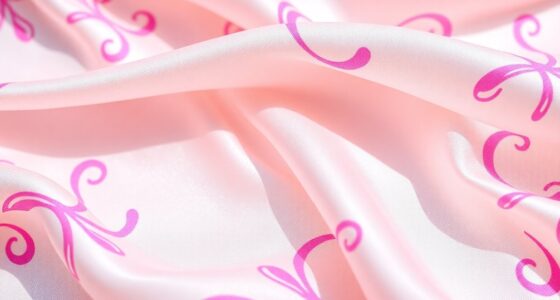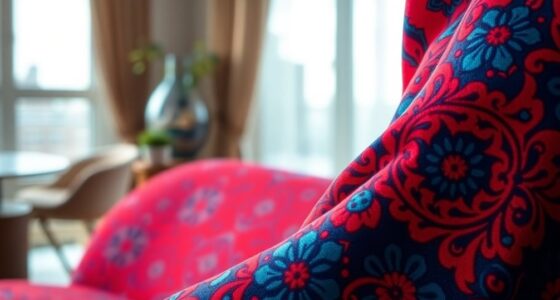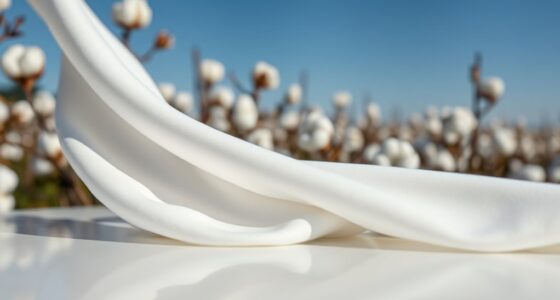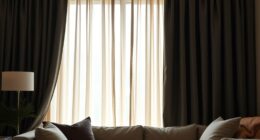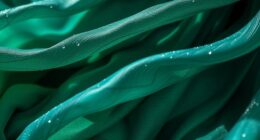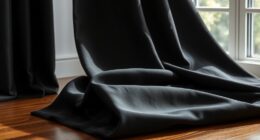Burlap's a robust and eco-friendly fabric made from jute fibers, perfect for all your DIY projects. Its natural beige color and rough texture add rustic charm to any craft, from home decor to gardening. Durable and breathable, burlap's also biodegradable, making it a sustainable choice. Plus, it's ideal for creating unique table runners, decorative pillows, and more. If you're curious about its history and versatile uses, stick around to discover even more!
Key Takeaways
- Burlap is a durable fabric made from jute fibers, known for its rustic appearance and eco-friendly properties.
- It is versatile for various DIY projects, including home decor, crafting, and gardening applications.
- The breathable weave of burlap prevents spoilage, making it ideal for agricultural uses and plant protection.
- Burlap's natural texture adds warmth and character to decor, enhancing rustic-themed events and interiors.
- While it has challenges like moisture sensitivity and rough texture, proper handling can mitigate these issues in projects.
What Is Burlap Fabric?

Burlap fabric, often referred to as hessian, is a robust and breathable textile made from jute fibers. Known for its strength and durability, burlap fabric is an eco-friendly choice, being both biodegradable and recyclable.
This rustic material features a natural beige color and a rough texture, adding charm to any DIY project or home decor. You'll find burlap fabric highly versatile; it's perfect for packaging, upholstery, gardening, and crafting.
Its unique aesthetic makes it a favorite for rustic-themed events like weddings. The manufacturing process highlights sustainability, involving the cultivation of jute, harvesting, retting, and weaving, minimizing waste generation.
With burlap fabric, you can create beautiful, environmentally conscious projects that stand out.
The History of Burlap Fabric
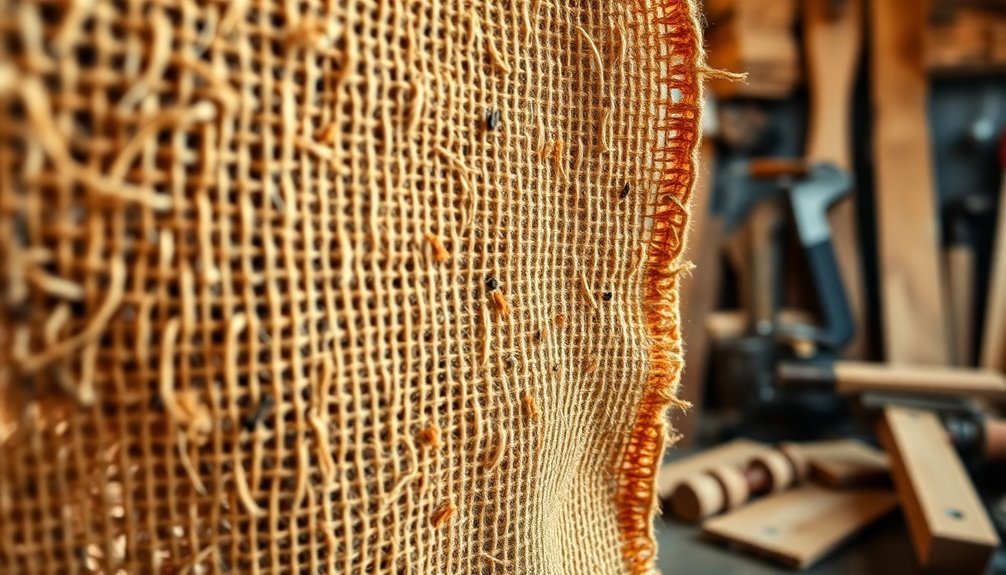
Burlap fabric has a rich history that traces back to the cultivation of jute in India and Bangladesh.
You'll find that it was widely used for bags and sacks in the 19th century and even played a crucial role during both World Wars.
As you explore its evolution, you'll see how burlap has transformed from a practical material to a beloved choice in rustic and eco-friendly decor.
Origins of Burlap Fabric
Throughout history, the origins of burlap fabric reveal a fascinating journey marked by practicality and sustainability. This coarse textile, primarily made from jute fibers, has stood the test of time for its strength and durability.
- Known as hessian in some regions
- Gained popularity in the 19th century
- Ideal jute cultivation in India and Bangladesh
- Eco-friendly and biodegradable
The production process involves harvesting jute stalks, retting to loosen the fibers, and weaving them into burlap fabric.
This showcases a blend of traditional craftsmanship and sustainable practices.
Today, as more people seek out eco-friendly alternatives, burlap continues to thrive, making it a beloved choice for DIY projects and home décor.
Traditional Uses and Applications
While many might think of burlap as a modern crafting staple, its roots run deep in agricultural and industrial applications. Traditionally made from jute fibers, burlap has been essential for packaging grains, potatoes, and coffee beans due to its durability. Known as hessian in Europe, it gained popularity in the 19th century for various industrial uses. Its breathable weave makes it ideal for gardening, protecting plants and preventing soil erosion. During the World Wars, burlap served in military applications, particularly for sandbags.
| Traditional Uses | Applications | Benefits |
|---|---|---|
| Packaging | Grains, Potatoes | Durability |
| Gardening | Erosion Control | Environmental Protection |
| Military | Sandbags | Strength and Versatility |
Evolution Through the Years
From its traditional uses in agriculture and military applications, burlap has evolved considerably over the centuries.
Originally known as hessian, this fabric made from jute fibers has a rich history that reflects its adaptability.
- First domesticated around 6,000 years ago
- Gained prominence during the 19th-century Industrial Revolution
- Utilized by farmers for grain and produce storage
- Resurgence in the 20th century as a sustainable crafting option
Today, burlap can be used in a myriad of creative ways.
Its rustic aesthetic makes it a favorite among crafters and designers for DIY projects, home decor, and event decorations.
Whether you're making tote bags or table runners, burlap's versatility continues to inspire creativity.
The Manufacturing Process of Burlap Fabric
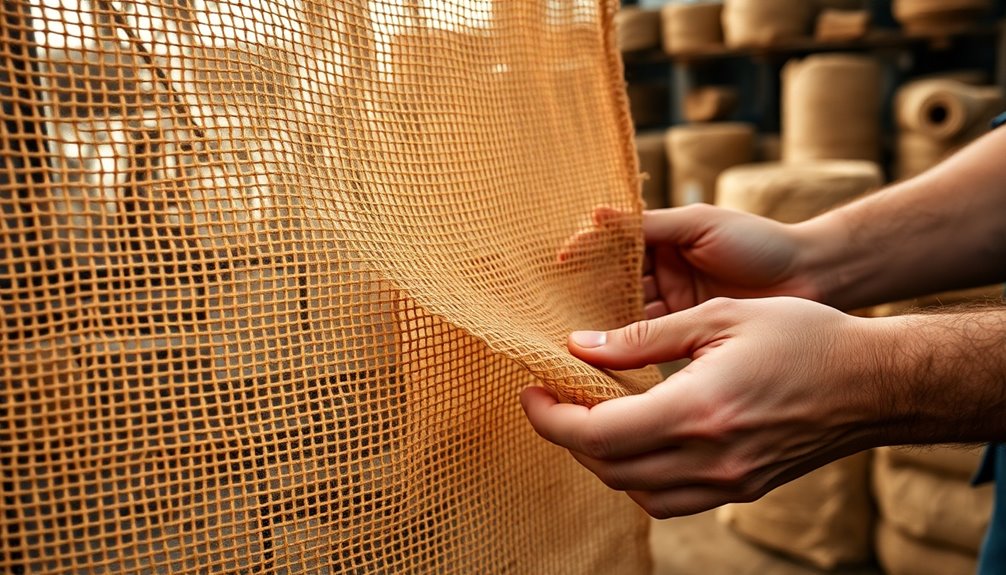
To understand burlap fabric, you need to start with the jute plant's cultivation and how it's harvested for the best fiber quality.
After harvesting, the fibers are extracted using specific methods before they're spun into yarn.
Finally, artisans weave this yarn into burlap, ensuring quality control throughout the process.
Jute Plant Cultivation
Burlap fabric begins its journey with the cultivation of jute, a resilient natural fiber sourced from the jute plant.
Primarily grown in tropical regions like India and Bangladesh, the cultivation process is both fascinating and sustainable.
Here's what you need to know:
- Farmers plant jute seeds in well-drained soil during the monsoon season.
- The jute plants can grow up to 10 to 15 feet tall in just a few months.
- After harvesting, the jute stalks undergo a retting process to loosen the fibers.
- The entire jute plant is utilized, minimizing waste and promoting environmental sustainability.
This efficient cultivation contributes considerably to the global jute production, making burlap a unique and eco-friendly fabric choice for your DIY projects.
Fiber Extraction Methods
The journey from jute cultivation to burlap fabric involves several key fiber extraction methods that ascertain quality and sustainability.
After harvesting jute plants at the right time, you'll find the stalks undergo a retting process, soaking in water to loosen the fibers for easier extraction.
Then, workers hand-strip the fibers from the stalks, ensuring that only the best quality fibers are selected through sorting and grading.
These sorted fibers are spun into yarn, with thickness adjusted based on the intended burlap use.
This meticulous attention to detail in fiber extraction methods ensures that the final product possesses the durability and texture that burlap is known for, making it perfect for all your DIY projects.
Weaving and Quality Control
Four essential steps define the weaving and quality control process of burlap fabric.
First, artisans carefully weave the high-quality jute fibers into burlap using handlooms or mechanized looms, creating that iconic open-weave pattern.
Next, they sort and grade the spun yarn based on quality, guaranteeing the best fibers are used.
Throughout this process, quality control checks maintain durability and aesthetic standards.
Here's what you can expect during this stage:
- Careful fiber selection
- Open-weave construction
- Regular quality inspections
- Adaptability for various applications
Finally, this meticulous attention to detail guarantees that your burlap fabric not only looks great but also stands the test of time, making it perfect for all your DIY projects.
Sustainability in Burlap Fabric Production

While considering eco-friendly materials for your DIY projects, burlap stands out due to its sustainable production practices. Made from jute, which grows quickly with minimal pesticides and fertilizers, burlap champions sustainability. The retting process uses water sustainably, while jute plants absorb carbon dioxide, aiding climate change efforts. Here's a quick overview of burlap's sustainability features:
| Feature | Benefit |
|---|---|
| Minimal pesticides/fertilizers | Supports sustainable agriculture |
| Water-managed retting process | Reduces environmental impact |
| Utilization of all jute parts | Promotes a circular economy |
| Biodegradable and compostable | Enriches soil without harm |
Using burlap not only enhances your projects but also contributes positively to the environment!
Common Uses of Burlap Fabric
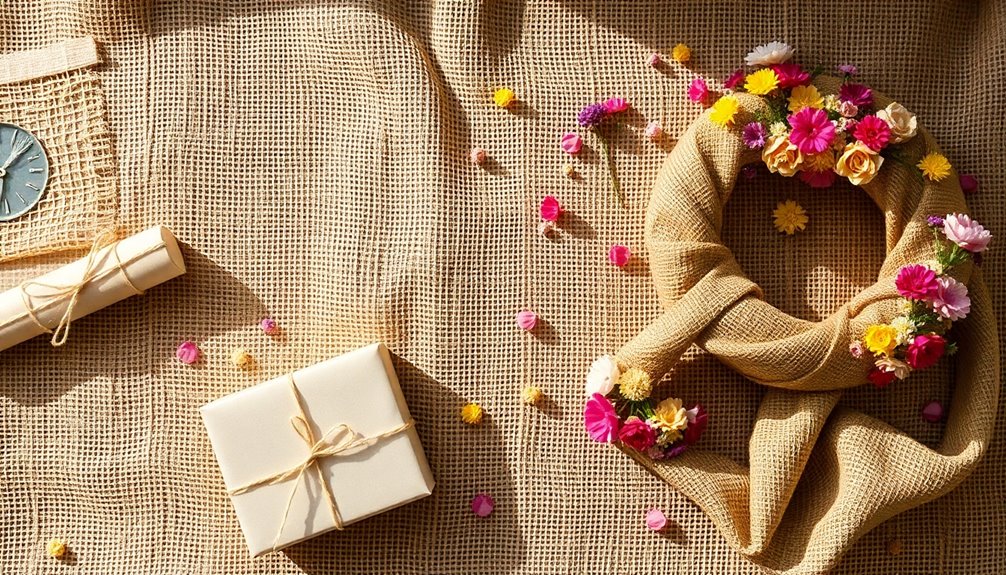
Burlap fabric is incredibly versatile, making it a popular choice for various DIY projects.
You can enhance your home decor with rustic table runners or create unique crafts like tote bags and wreaths.
Plus, when it comes to gardening, burlap helps protect your plants while promoting healthy soil.
Home Decor Applications
When you're looking to add a touch of rustic charm to your home, burlap fabric offers a multitude of creative applications.
This versatile material can transform your living space with its natural texture and warmth.
Consider these popular uses:
- Create rustic curtains that breathe life into any room.
- Craft charming table runners and placemats for your dining area.
- Design unique throw pillow covers to enhance your living room's aesthetic.
- Incorporate burlap in event decorations, like centerpieces and chair sashes for weddings.
Crafting and DIY Projects
Crafting with burlap opens up a world of creative possibilities for DIY enthusiasts. This rustic fabric, made from durable jute fibers, is perfect for various projects, from table runners to unique furniture accents. Its rough texture and eco-friendly properties make it a favorite among crafters. Additionally, using burlap in your projects can contribute to a more environmentally friendly option that reduces your carbon footprint.
Here's a quick overview of common burlap DIY projects:
| Project Type | Description | Use Cases |
|---|---|---|
| Home Decor | Table runners, placemats, pillows | Living rooms, kitchens |
| Event Decorations | Wreaths, centerpieces | Weddings, parties |
| Furniture Accents | Upholstery, stenciled designs | Chairs, benches |
| Sustainable Crafts | Biodegradable crafts | Eco-friendly projects |
| Community Initiatives | Bulk purchases for events | Awareness campaigns |
Get creative and enjoy crafting!
Gardening and Landscaping Uses
After exploring its creative applications in crafting, you might be surprised to learn that burlap also shines in gardening and landscaping.
This rustic burlap fabric offers several practical benefits:
- Creates biodegradable planters that promote natural growth.
- Protects plants from harsh weather while retaining moisture.
- Prevents soil erosion by stabilizing seeded areas.
- Serves as a sturdy barrier for wrapping root balls during transplanting.
Using burlap fabric in your garden helps foster a healthy environment for your plants.
Its breathable weave allows for air and moisture penetration, while its rough texture aids in reducing transplant shock.
Plus, when used in landscaping, burlap effectively creates weed barriers, letting water through but keeping unwanted plants at bay.
Properties and Advantages of Burlap Fabric
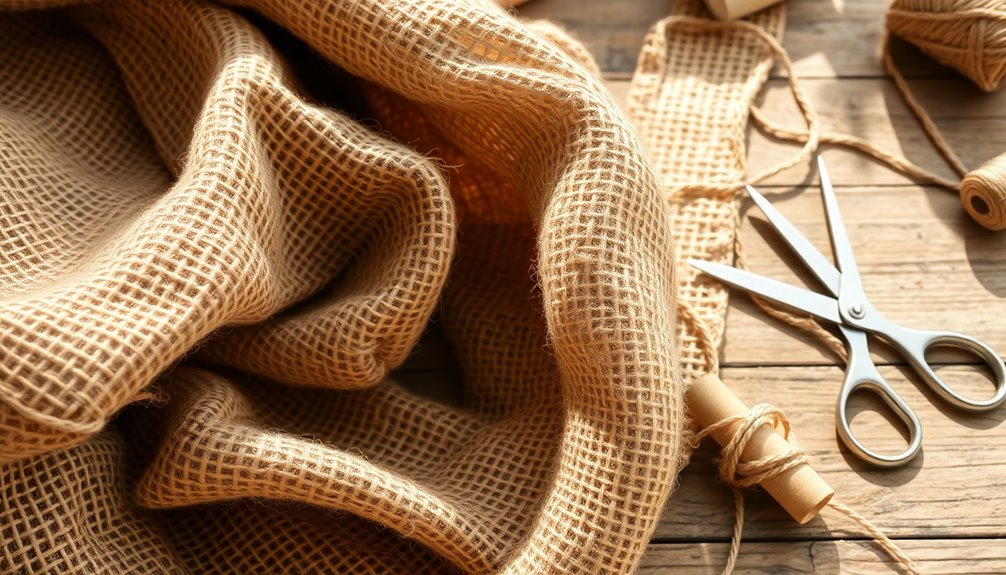
Burlap fabric stands out for its remarkable properties and advantages, making it a top choice for various DIY projects. Its rustic charm, combined with durability from strong jute fibers, makes it perfect for heavy-duty tasks like upholstery. The breathable weave allows air circulation, preventing spoilage during agricultural uses. Plus, burlap is eco-friendly and biodegradable, appealing to environmentally conscious consumers. Additionally, its versatility can be seen in various diets where it serves as a natural and sustainable option for crafting projects.
| Property | Advantage | Use Case |
|---|---|---|
| Durability | Suitable for heavy-duty tasks | Upholstery, packaging |
| Breathability | Prevents spoilage | Agricultural storage |
| Eco-friendliness | Contributes to soil health | Gardening applications |
This unique combination of features enhances your DIY projects while adding a touch of warmth and character.
Challenges of Using Burlap Fabric
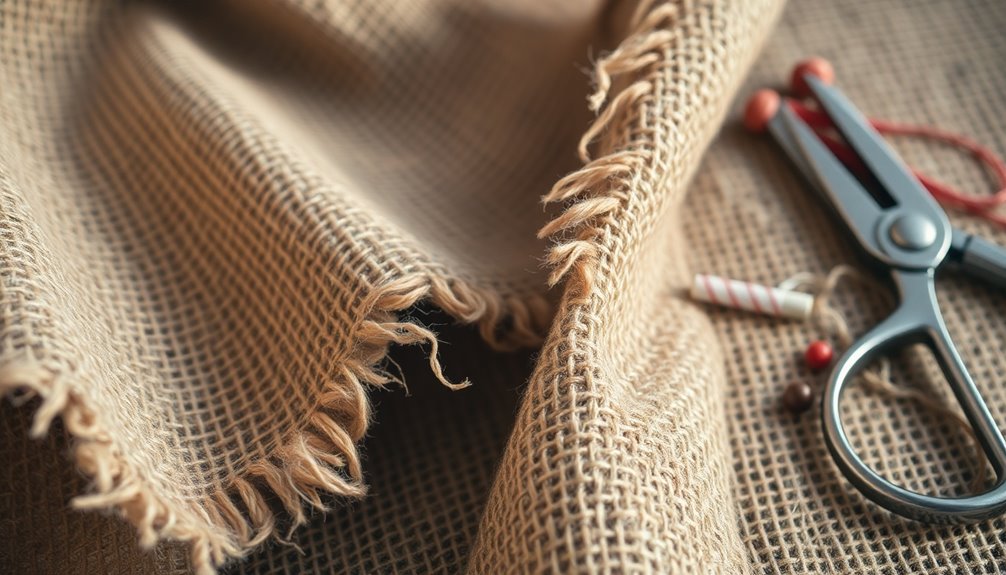
While burlap's rustic appeal makes it a popular choice for DIY enthusiasts, several challenges can arise when working with this fabric.
Here are some issues you might encounter:
- Moisture Damage: Burlap can develop mildew if stored in damp conditions.
- Rough Texture: This fabric may irritate your skin, making it unsuitable for clothing.
- Fiber Shedding: Burlap tends to shed, creating a mess during your projects.
- Limited Color Options: The traditional color range may require dyes or layering to enhance designs.
These challenges of using burlap fabric can impact your DIY experience.
Being aware of these potential issues will help you navigate your projects more effectively and achieve the desired results.
How to Care for Burlap Fabric
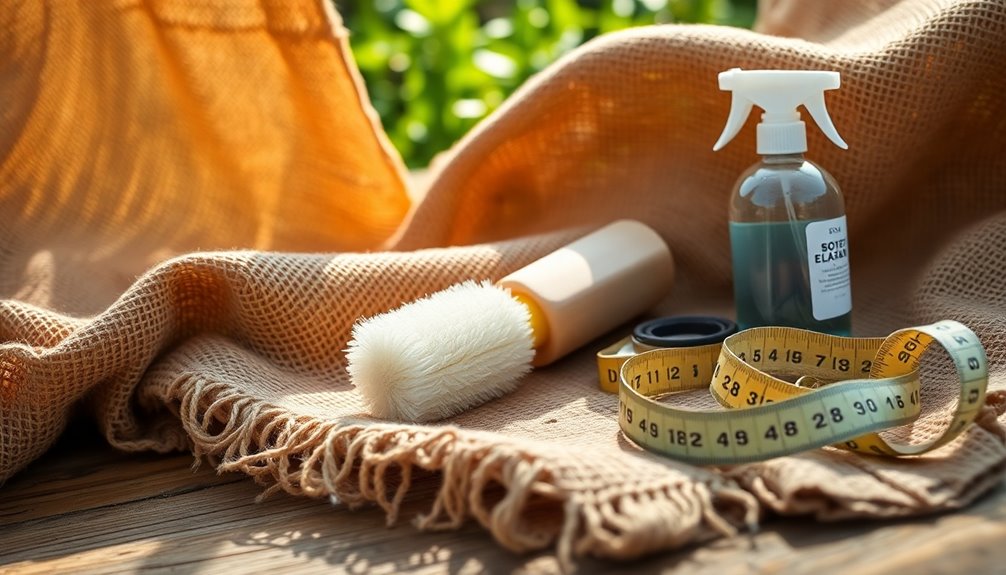
Understanding the challenges of working with burlap fabric is just the beginning; proper care is vital for maintaining its quality and longevity.
To clean burlap, skip the machine washing. Instead, use a mild soap solution with water, blot stains, and let the fabric air dry to keep its integrity.
Store burlap in a cool, dry place, rolling it to avoid creases and maintain its shape. For maintenance, use low-heat steam to remove wrinkles, as high temperatures can weaken the natural jute fibers.
Always make sure burlap is completely dry before storage to prevent mildew and unpleasant odors.
Finally, regularly inspect your burlap for signs of wear or damage to keep it in top condition for your upcoming DIY projects.
Creative DIY Projects Using Burlap
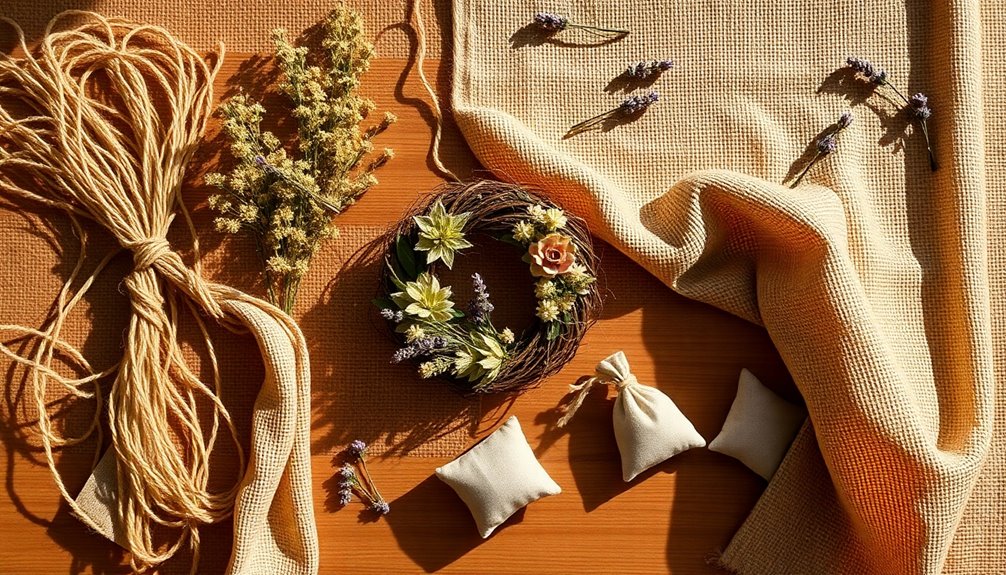
Looking for a material that combines rustic charm with endless versatility? Burlap fabric is your go-to choice for countless DIY projects.
Here are some creative ideas to inspire you:
- Craft charming table runners for a cozy dining experience.
- Create unique placemats that add character to your table settings.
- Design chic throw pillow covers that enhance your home decor.
- Make beautiful wreaths to welcome guests all year round.
With its sturdy and breathable texture, burlap elevates any project.
Plus, its eco-friendly properties lend themselves to sustainable crafts like biodegradable plant wraps.
Whether you're planning a wedding or sprucing up your home, burlap's affordability makes it easy to buy in bulk for larger projects.
Get crafting!
Exploring Alternative Fabrics to Burlap
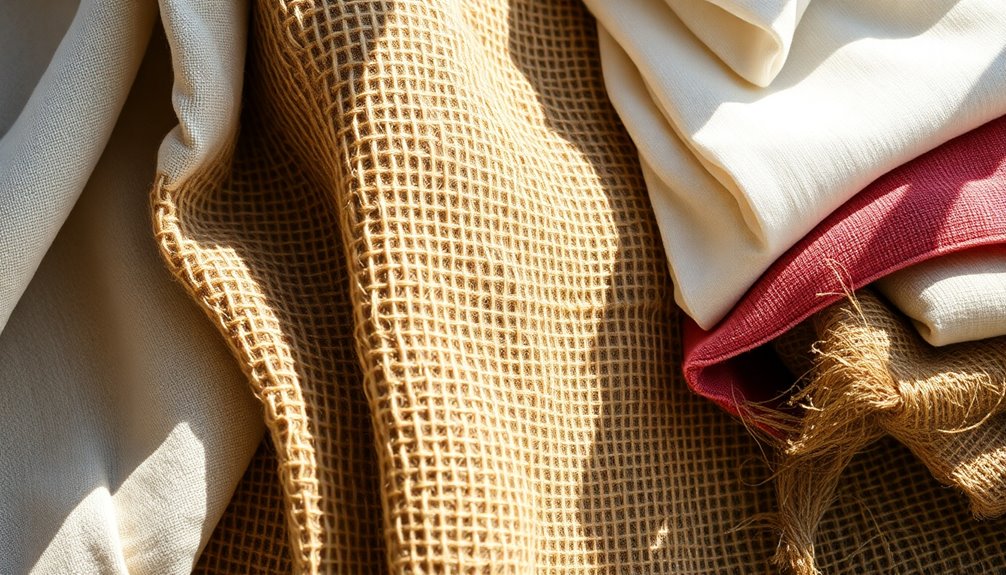
If you're seeking alternatives to burlap for your next DIY project, you'll find a variety of fabrics that offer similar rustic charm and functionality.
Consider 100% hemp, which has a tighter weave and softer feel, perfect for slipcovers and home decor.
Linen canvas provides an upscale look that softens with washing, making it ideal for frequent use.
For practicality, synthetic options like Hailey basket weave offer stain resistance while mimicking burlap's appearance.
Coarse linen is another excellent choice, providing a similar texture with a softer touch.
Finally, cotton fabrics in tan or natural colors and Osnaburg, with its nubby texture, serve as cost-effective alternative fabrics that retain a rustic aesthetic without burlap's downsides. Additionally, incorporating natural materials in your projects can enhance the farmhouse style and create a more inviting atmosphere.
Frequently Asked Questions
Is Jute Fabric the Same as Burlap?
No, jute fabric and burlap aren't exactly the same.
While burlap is made from jute fibers, it specifically refers to the coarse, heavier textile often used for rustic projects.
Jute is the raw material, and it can be processed into various fabrics with different textures and weights.
What Happens to Burlap When It Gets Wet?
Did you know that burlap can absorb up to 30% of its weight in water? When burlap gets wet, its jute fibers soak up moisture, leading to a heavy texture and potential mildew growth if not dried properly.
You'll notice a strong odor if it stays damp too long. Plus, excess moisture can cause it to fray and lose its structure, making it less durable for your projects.
Always guarantee it's completely dry before storage!
How to Sew Burlap so It Doesn't Fray?
To sew burlap without fraying, start by securing the edges with a zigzag stitch or a serger before cutting. A fabric fray check solution can also help seal the raw edges.
Use a walking foot on your sewing machine to keep the burlap feeding evenly. When cutting, always follow the weave with a rotary cutter for cleaner edges.
Finally, choose a heavier weight needle, like a 90/14, to handle the coarse fibers effectively.
What Is the Difference Between Synthetic Burlap and Natural Burlap?
You might've noticed that burlap comes in two flavors: natural and synthetic.
Natural burlap, made from jute fibers, has that rustic charm and eco-friendly vibe. On the other hand, synthetic burlap, often polyester, offers a smoother texture and is more resistant to stains and moisture.
While natural burlap absorbs odors, synthetic burlap comes in a rainbow of colors. Your choice depends on whether you want a more organic look or something easier to maintain!
Conclusion
In summary, burlap's beautiful blend of durability and distinctiveness makes it a delightful choice for DIY devotees. Whether you're crafting charming decorations or creating practical pieces, this rustic fabric brings both style and substance to your projects. Remember, while burlap boasts many benefits, it also comes with its own set of challenges. So, as you commence your burlap journey, stay savvy, seek inspiration, and savor the satisfaction of your stunning creations!


